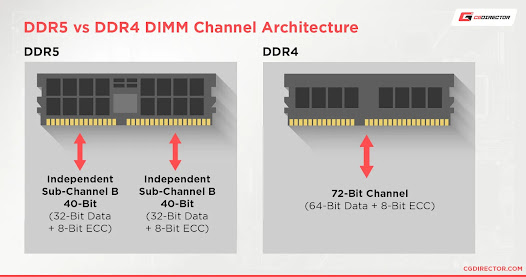12th Gen Intel® Core™ CPUs adapt to the ways you work and play. When gaming, the processor prevents background tasks from interrupting or using your high-performance cores. When working, it provides a smoother system-level experience while using demanding applications.
12Th Generation Processors Line-up's [ Intel Alder Lake-S Architecture ]
Highlighted :
12th Gen CPUs integrate two types of cores into a single die: performance-cores (P-cores) and efficient-cores (E-cores).
Performance-cores :
- Physically larger high-performance cores designed for raw speed while maintaining efficiency.
- Optimized for low-latency single-threaded performance and AI workloads.
- Capable of hyper-threading, or running two software threads at once.
- Measured at 19% better performance, on average, than 11th Gen Intel® Core™ CPUs across a wide range of workloads at ISO frequency3.
Efficient-cores :
- Physically smaller, with multiple E-cores fitting into the physical space occupied by one P-core.
- Optimized for multi-core performance-per-watt—delivering scalable multithread performance and efficient offload of background tasks.
- Capable of running a single software thread.
- Capable of 40% more performance when running at the same power as a single Skylake core4.

DDR5 Memory Details :
DDR5 is the next-generation specification for RAM and it comes with a host of improvements in speed and efficiency when compared to DDR4, the current standard.
- Higher-bandwidth kits thanks to doubled burst length—the number of bits that can be read per cycle.
- 12th Gen supports speeds up to 4,800MHz for DDR5 and 3,200MHz for DDR4.
- DDR5 allows capacities of up to 128GB of RAM per module, whereas DDR4 allows only 32GB.
- DDR5 doubles the number of memory bank groups and improves the speed at which groups can be refreshed.
PCIe 5.0 :
12th Gen Intel® Core™ CPUs are at the forefront of the industry transition to PCIe 5.0. PCIe 5.0 doubles the bandwidth of 4.0, which means your system will be ready for the next generation of SSDs and discrete GPUs.
PCIe is the high-bandwidth expansion bus used to connect graphics cards, SSDs, and other peripherals to your motherboard. Each generation of PCIe doubles in throughput, with PCIe 5.0 providing theoretical maximum data transfer speeds of 32 GT/s.
- Full backwards compatibility with PCIe 4.0 and 3.0 devices.
- Double the bandwidth of 4.0 and four times the bandwidth of 3.0.
- Up to 16 CPU PCIe 5.0 lanes and up to 4 CPU PCIe 4.0 lanes.
Intel UHD Graphics 64EU :
The UHD Graphics 64EU is a mobile integrated graphics solution by Intel, launched on January 4th, 2022. Built on the 10 nm process, and based on the Alder Lake GT1 graphics processor, the device supports DirectX 12. This ensures that all modern games will run on UHD Graphics 64EU. It features 512 shading units, 32 texture mapping units, and 16 ROPs. The GPU is operating at a frequency of 300 MHz, which can be boosted up to 1400 MHz.
Its power draw is rated at 45 W maximum.
General info
Of UHD Graphics 64EU's architecture, market segment and release date.
- Place in performance rating not rated
- Architecture Generation 12.2 (2021−2022)
- GPU code name Alder Lake GT1
- Market segment Desktop
- Release date 4 January 2022 (less than a year ago)
Technical specs
- Pipelines / CUDA cores 512 of 18432 (AD102)
- Boost clock speed 1400 MHz of 2903 (Radeon Pro W6600)
- Manufacturing process technology 10 nm of 4 (H100 PCIe)
- Thermal design power (TDP) 45 Watt of 900 (Tesla S2050)
- Texture fill rate 44.80 of 939.8 (H100 SXM5)
Memory :
- Memory type System Shared
- Maximum RAM amount System Shared of 128 (Radeon Instinct MI250X)
- Memory bus width System Shared of 8192 (Radeon Instinct MI250X)
- Memory clock speed System Shared of 21000 (GeForce RTX 3090 Ti)
API support :
DirectX 12 (12_1)
Shader Model 6.4
OpenGL 4.6
OpenCL 3.0
Vulkan 1.3





No comments:
Post a Comment